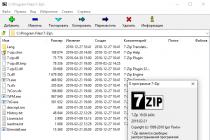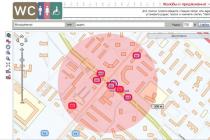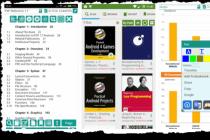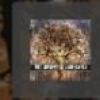Yandex is a modern way to search for information, news and other data that users need on a daily basis. Here you can also create a free mailbox, get acquainted with the schedule and exchange rates. A unified source of any information, a real guide to the World Wide Web is the domestic service Yandex.
Where to begin
You can get to the Yandex home page by entering https://yandex.ru/ in the address bar of your browser. After that, the user will be on the main page of the Yandex ru service.
Top center settled down latest news, to the right you can enter your e-mail and check your mail. Slightly below, to the left of the logo, there is a search bar, under which is located basic information about traffic jams, weather and a map of the city in which the user is located.
Setting as start page
As soon as you start the browser, the first page it opens is called the start page. When you visit Yandex, the site offers to make the service a start page. If you click " I accept", Then with each subsequent launch of the browser, your work will start with home page.
Yandex search
Get hold of necessary information with Yandex as easy as shelling pears. Start typing your request, and search system will automatically suggest possible options. 
Above the search bar there are services that simplify this process. Need pictures? Click on the corresponding link. Video? Not a problem, Yandex is ready to search for the video you need. There are other services available in the "More" tab to simplify the search.
This is an advanced search. 
Here can be clarified specific region, select a search by the site of interest, or filter sites by publication date. Please note: in the lower right corner, Yandex offers to install the start page and the main search engine. Click "OK" and the system will do the rest automatically.
Location
Yandex determines your location automatically in order to show actual news and data such as weather and traffic for the region the user is in. Do you want to change the region? Not a problem. Click on the default city. 
After that, you will be taken to the page location selection... Click "Find me" to let the service update your location information automatically, or enter the name of the settlement in the line below. 
Yandex News
The latest developments in the region and the world are located in the very top of the window where you can switch between news. By clicking on the event of interest, the user will go to the Yandex News service page. 
Here you can read in detail with the latest events in the country and the world, sort the news into categories, and get acquainted with the events of interest to the user.
additional services
Above the search bar are additional services that make it easier to work with information:
- Video: Find a video you are interested in, or check out the latest updates.
- Pictures: Search the images and photos you want with ease, or just look at trending images.
- news: the service already described above, allows you to always be aware of events.
- Cards: helps to easily navigate the terrain, and find the desired locations right on the map.
- Marketplace: look at the products on sale and order the one you want in one click.
- Interpreter: translation of texts with support for a large number of languages.
- Music: create your own collection of audio recordings, or listen to your favorite songs online.
Everything that does not fit above the search bar can be found in the “ Yet". The available options include job search projects, a poster and many other resources.
Additional links
Information about the service is located at the bottom of the title page, and contains the following items:

Installing the theme
To make the design more colorful and interesting, the developers suggest installing on it one of the many themes that change the appearance of the site. This is as easy as shelling pears to do. In the upper right corner there is a menu “ Customization", In which you need to select the item" Put the topic», After which a list of available themes will open. Installation is free and done in a matter of seconds. 
For example, the Star Wars theme. 15 seconds - and from the start page the most formidable Jedi of the galaxy is looking at you. 
What else can be configured
In the same menu “ Settings»There are several other points:
- Location: as mentioned earlier, here you can set the settlement in which the user is located.
- My places: Add places like home and work to the map.
- Language: Choose which language the site will be displayed in.
- Search settings: Several options to simplify and personalize your search.
- Advertising: make it more interesting for yourself, or remove it altogether.
- Notifications: what do you want Yandex to tell you about?
- Passport: Additional security settings and the entry of personal information such as a phone number.
Yandex Passport
To obtain a passport in Yandex, you must enter your first and last name, login and password, and specify the number mobile phone. Registration takes no more than two minutes, after which many options become available to the user, including binding bank card, password change and security settings, and many other functions.
How to ask a question to the support service
In order to learn about the work of services and services, visit the section " Feedback». 
Here you can get acquainted with the basic instructions for working with the portal, find out the necessary information, and, if necessary, contact the support service for clarifications.
Today we set off on another long journey along the ornate paths of search engine development ( Яndex, Yandex). I think that the domestic giant of network search has long ago grown to such a level that it is not too lazy to dig all its lobbies, remember how the Yandex search engine developed, what was interesting over the years of its existence.
Moreover, it receives a lot of visitors from the Yandex search engine. Many of them are leaving for contextual advertising, I recently accepted the blog, so I believe that this company is more than worthy to write a large publication about it.
If we take into account the Russian Internet, then here Yandex is the undisputed leader. In Russia, this is the first search engine in terms of importance. There are regional search engines, a kind of branches in Belarus, Ukraine, Kazakhstan. Yandex is very popular among residents of these countries. I can judge this at least by statistics, seeing that a lot of visitors come from other regions.
Currently Yandex is not only a search engine, it is also numerous services that can be accessed by absolutely all users of this search engine. Here you can find and necessary information, and navigate the choice of leisure, find pictures, goods, compare prices, watch the weather, communicate on a social network, watch the schedule of TV programs, transport. There are numerous corporate solutions. You can even go to Narod.ru. Yandex has a convenient system that implements functionality for working with your sites. Among the latest available innovations of the service - which remained paid for a long time, but in December 2011 this service became available to absolutely everyone.
You can go on about the wonderful technologies and useful services of Yandex for a very, very long time. Therefore, for the convenience of the perception of information, I will break our journey into components. I will describe the entire path of the search engine in chronological order by year - from its creation to the present time.
Yandex development history
1980s - 1990s
History of Yandex development takes its roots in the now distant 80s, the existence of the USSR. It was then that development began for the first time software for search in the Arcadia company. The work was carried out under the leadership of Arkady Borkovsky and Arkady Volozh. It was that first search technology received the name "Яndex". And the Yandex site itself, the same one that we can see today, appeared in 1996. The developments that were carried out at that time were recognized as promising, as a result of which the management of CompTek (sale of computers and components) and the developers of the system decided on the feasibility of further developing the technology and introducing it to the masses. In this regard, a concept for the development of the project was prepared, aimed at a wide audience.

Yandex was officially announced only on September 23, 1997. And in fact, at first it was one of the divisions of CompTek International. That is, independence there was generally a gulkin's nose. And only in 2000 Yandex became the company that you can see it today. In the sense that the company has already become completely independent. Independent Yandex.
By the way, long before the announcement of the search engine Yandex, the companies came up with a name. Yandex - means "Language index". If translated from English, it turns out "Yet Another indexer". However, later, as the search engine developed, other interpretations began to appear. For example, if you translate the first letter (I - I) from English into Russian in the English Index, you get "Яndex".
They came up with the name "Yandex" Ilya Segalovich (current director of technology), and Arkady Volozh
A year before the official release of the company, on October 18, 1996, the Netcom'96 exhibition took place, at which CompTek presented the first products of the developing search engine. These were Yandex.Site and Yandex.Dict. Then, six months later, Yandex.CD appeared - searching for documents on CD-ROM, and then the Yandex.Lib project started. It was a Yandex package library that was designed to be embedded in all sorts of applications and databases.
At the time when Yandex.ru was officially presented to the public, the following can be distinguished from the interesting:
Assessment of the relevance of documents. At that time, Yandex was pretty good at finding copies and excluding them. At the same time, documents were searched in various encodings.
Search by exact word form. Yashka knew how to search based on morphology
Search based on distance. Yandex was able to search within a paragraph, by exact phrases
Functioned core for assessing the relevance of pages. For each request, documents were selected taking into account their relevance (relevance) to the request. In addition, when selecting documents for search results, the frequency (density) of the keyword on the page was taken into account. By the way, precisely because of the imperfection (at that time) of this algorithm, pages densely packed with keywords, in fact, without meaning, appeared in the top of the search results.
Also, the search took into account the distance between words, and how the words are located in the document.
Yandex website design
The very first design for the Yandex site was rather primitive and imperfect. It was developed by the well-known Artemy Lebedev. He looked like this

By the way, the Yandex forum was opened in the same year. It was intended for communication between system users and developers. The idea was good and the forum functioned well. True, it existed until 2008. Then there was a slight reshuffle of priorities. As far as I can tell, the preference was given to socialization. Yandex also began to actively develop its own social network, on the basis of which the current blog appeared, where all Yandex announcements are published, and where, in fact, the communication between users and developers takes place. You can see for yourself, the old forum url ( http://forum.yandex.ru/yandex/) today redirect to the well-known http://webmaster.ya.ru/.
1998 year
The project, which got started, showed good potential, they continued to work on it. In 1998, the search engine was improved, and many other functionalities were introduced for users. In particular, it became possible to search in what was found, search for similar documents and much more. Work is also underway on the design of the Yandex home page. Now she has changed a little

As you can see, outwardly, nothing has changed much. To a greater extent, technical work was carried out
1999 year
Over the year, the audience of the Russian share of the Internet has grown significantly. Together with it, the quality and technology of Yandex have grown, the developers have introduced many improvements. The Yandex search engine has introduced a new search bot, which significantly increased the speed of crawling documents on the web.
The innovations that affected the custom parts of the functionality were as follows:
Now you can search more specifically - by annotations, signatures, pictures, titles
We have introduced a search restriction for a group of sites
Separately highlighted documents in Russian
By the way, it was in 1999 that the well-known concept (thematic citation index) was first introduced to everyone today. True, then it was calculated rather primitively. The authority of the site (aka TIC) depended to a greater extent on the number of sites that linked to the domain of interest to us.
The design of the main page, by the way, has also changed. Now it has become already something more similar to the current one.

It was in 1999 and another significant event. It was then that a free website builder appeared, better known to all of us as Narod.ru (free hosting and file sharing). By the way, this project still exists. The motto of this project was as follows - in 60 seconds.

year 2000
Perhaps it was the introduction of new services that allowed Yandex to reach a fundamentally new level of development. Over time, the search engine firmly cemented its status, which made it possible significantly. In fact, it was already a new project, not the one that started under the auspices of CompTek.
In 1999, Arkady Volozh, realizing the prospects for the development of the project, began to engage only in promoting Yandex. But the difficulty at the same time was that it was necessary to find experienced partners who would have the skills of corporate building. The only difficulty was that it was necessary to find such partners who would invest in the development of the project, but at the same time would not require a complete transfer of management to their own authority.
And such a partner was found. It was the company ru-Net Holdings... In the spring of 2000, an investment agreement was signed with this company. Here, however, there were some casualties. A certain share of the search engine still had to be given. According to the agreement, 1/3 of the search engine left the company. That is, from that moment on Yandex ceased to be a structural division of CompTek, but became an independent company, which had its own offices, its own management, its own budget, etc. The Director General Arkady Volozh became the company.
I think Yandex was very lucky with its first head, because Volozh turned out to be not only a specialist in finding potential partners, but also a good innovator. After the start of an independent "voyage" in the company, tremendous changes began. The staff has significantly increased, and the resource itself has received a new kick from its leaders.
In total, ru-Net Holdings invested about $ 5 million. What can I say, the deal turned out to be very profitable, especially considering the fact that today the number one search engine in the Russian Internet will cost at least several hundred million dollars. This is at the most conservative estimate.
The year 2000 became significant also for the reason that it was in this year that Yandex's multiportality began to emerge more clearly, for many services began to appear that were not directly tied to search. Such services are Yandex.News, Yandex.Mail, Postcards, a search bar at ya.ru. In addition, there were many services that later merged, becoming what we know today as Yandex.Market. In addition, another significant innovation was the introduction of specialized software for integration into user browsers - Yandex Bar.
year 2001
This year became a turning point, because in 2001 Yandex became the leader of the Russian Internet in terms of attendance. In addition, the amount of information stored on the company's servers has grown. Its size was 1 terabyte. By the way, Yandex.Pictures appeared this year as well. In addition, an electronic payment system Yandex money

In addition, the design of the Yandex home page has been significantly improved. Links to new services and news appeared here. We can say that, in general, the outlines of today's Yandex have already appeared.

2002 year
This year, the developers have been actively working to improve the communication service - Yandex.Mail. A lot of work has been done to filter the correspondence. 2002 was the year of the merger of three services - Goods, Guru and Pick into one - Yandex.Market. By the way, you can see for yourself that this service is very relevant even today. Perhaps, for the first time in all the years of investing in 2002, there was a goal - to reach self-sufficiency. It was necessary to develop a strategic system for the monetization of the project. Moreover, one that would bring stable and large profits in the future. It has become such a model, and it is precisely the income that the company began to receive from this advertising model that made it possible to reach self-sufficiency much earlier than expected. Therefore, we can say that 2002 was a turning point in terms of entering a business-oriented model, which, moreover, has already begun to bear fruit.
2003 year
Active work on the Yandex.Mail service continued this year. Here, the next massive changes were introduced that affected all users of the system. Of course, Ya. Mail has become more functional and convenient. Looking ahead, I want to say that in the future the service has also developed very actively, and its users have seen many new interesting features more than once. In particular, users received an unlimited mailbox size and a new spam filter "Spam Defense". In 2003, the Yandex design was renewed again.
By the way, each design corresponded to a specific version. The 2003 version of the design was the eighth in a row, and it looked like this

Any rollout new version design initially goes through a beta testing period. And if before that beta tests were conducted in a closed mode, then this time, in two weeks of trial testing of the new interface, anyone could get access to the new interface. True, a year later the main one was upgraded again, but more successfully. And it existed in this form until 2007.
Yandex even at that time was already a fairly reputable company, because already in 2003 the Yandex search engine was successfully introduced into the presidential website. In the fall of 2003, the developers rolled out the next product updates: Yandex.Publisher (Yandex.Publisher), Yandex.Server (Яndex.Server), which became the legacy of Yandex.Site.
2004 year
The business model, occupied by the number one search engine in the Russian Internet, worked very well, as a result of which the profit received by the company in 2004 was already tens of millions of dollars. This gave impetus to the development of new services, for example, a map search service, blogs, forums. The year 2004 is also notable for the fact that it was then that a serious competitor in the face of Google appeared on the Russian market. There was an urgent need to join the struggle for leadership, as a result of which the management of Yandex decided to increase its staff tenfold. Initially, there were 200, after the renewal of the staff, there were 2,000 employees. But the main thing is that after the personnel update, nothing has changed for the worse. The traditions remained, the technologies were also up to par. In general, we can say that Yasha has not turned into a dry corporation.
The battle of technology: Yandex vs Google
2005 year
This year passed under the slogan of the geographical expansion of the company's representative office. Because a Ukrainian representative office of Yandex appeared - Yandex.Ukraine. By the way, the director of this representative office is Sergey Petrenko, the founder of the well-known serch and the author of the interesting blog BloGnot

2005 became significant also because my beloved was opened. This is a service on the principle of "kolotibablo webmaster", and if in Russian, it is a service that allows webmasters to place advertisements on their sites.
Yandex.Dictionaries appeared in the same year. Changes have also taken place in the Yandex.Money service. Now all users have the opportunity to manage their account through the Internet wallet.
2006 year
This year will be remembered for the appearance of the now well-known service blogs.yandex.ru. This is a kind of marketing tool. Allowed to study public opinion, reviews in blogs, forums. Yandex.Maps introduced a traffic display tool.
From 2006 to 2010 Yandex was located in the old office on Samokatnaya street in Moscow



As you can see, they were a bit cramped earlier. It's not now, a huge building with 2,000 employees.
In 2006, there was another interesting event - the first remote development office was opened in St. Petersburg. Then, of course, the scale was not yet the same. This is not like Yandex currently has 11 offices in Russia, Ukraine, Turkey and even California. Offices differ in their types of activities. There are development offices, sales offices, offices that work in the direction of product localization
2007 year
This year there have been more webmaster-oriented events. In particular, the Yandex.Photo service has appeared. But for me, as a webmaster, a more interesting event is the emergence of the service Yandex.Metrica... True, at that time it was a completely crude service, and it was focused not on webmasters, but on Yandex.Direct advertisers. In the same year, a Ukrainian representative office was opened - Yandex.ua. Today, according to LiveInternet data, almost 14% of Russian-language traffic falls on yandex.ua

Also in 2007, he started a project known to all webmasters, which is not used now, probably only lazy
2008 year
We can say that this year Yandex's sphere of influence has increased so much that it was decided to open a branch of the search engine in the USA, California. At the same time, significant additions were made to the algorithms. In particular, the international standards Sitemap, MediaRSS, etc. began to be supported. That is, as you can see, the spheres of interest have gone far beyond the limits of the Russian Internet. The number one search engine of the Russian Internet has now become English-language sites. Before that, the problem was that the domestic search engine did not support international standards, and therefore there was a problem with the indexing of sites from the bourgeoisie, but after the 2008 upgrade, this problem was solved. And after that, the Yandex logo began to be written entirely in Russian.
year 2009
This year was significant because before that there was no division of search by region. That is, before the introduction of this algorithm, it was built on the principles of uniformity. You enter, for example, in the search line the query "" in Moscow and Novosibirsk, and you get the same results. Now everything has changed. And the search results are mixed with results based on the principle of geo-dependence. Simply put - if you search with Yandex in Moscow and Novosibirsk, the results will be different.
In 2009, work continued in the previously selected western direction. In particular, a service was tested with the help of which foreign sites were translated. Then this service evolved, and in 2011 it became known as Yandex.Translation.
An equally important event was the introduction of a new method machine learning – Matrixnet... This technology applies various patterns as an assessment, and takes into account various ranking factors. But the main thing is that the technology is self-learning. When assessing assessors, only real patterns are assessed, finding nonexistent ones is completely excluded.
The revolutionary nature of this technology lies in the fact that Matrixnet uses an incredibly complex ranking formula that takes into account a huge number of factors. This, on the one hand, allows you to achieve better search results, and on the other hand, it will not allow webmasters to understand this pattern, and, therefore, to influence it in their own interests.
MatrixNet technology in detail:
2010 year
The old office on Samokatnaya street is a thing of the past, and the whole company has moved to new mansions. Actually, it became the main event of 2010



Hello dear readers of the blog site. Today I want to talk about the most successful Internet company on the Russian Internet.
If you think about it, more than half of the users come to my blog from this one, and the lion's share of mine comes from income from the display of YAN ad units (through the Profit Partner).
For webmasters, probably, first of all, Yandex is a search engine that occupies a leading position in Runet (it even absorbed recently). Moreover, the realities of the modern are such that not taking into account the peculiarities of this search engine when optimizing a site would be extremely unwise, because it is she who aggregates the lion's share of commercial requests. Not getting targeted visitors from it is not a fact that you can get them from, because they simply may not be there.
Yandex home page, themes and settings
But at the same time Yandex has long ago outgrown the short pants of a pure search engine and has become for many users the place from which they begin their journey on the Internet - a multi-portal. Millions of users now use its image search, Mail, and dozens of other services. The main rival Google all this is also there, but nevertheless, the audience of our network segment votes for the majority of the domestic manufacturer.
Let's start our review of the portal from its main page. Many experts worked on its creation and layout, and it is on the start page that you will find almost everything you may need at first. Only then, having got used to it a little and having decided on which services you will need in the first place, you can completely rebuild it to suit your taste and needs.

About registration, receiving a mailbox and about that, we will talk a little lower in the text. Now let us note for ourselves that already a lot of what the majority of users may need, has a place to be on the main page. In orange, I underlined the services that I myself periodically use.
Also on the main page, when you scroll through it, you will find a list of Internet materials that may be of interest to you. Yandex knows your preferences and tries to show only the most interesting for you in this feed. Judge for yourself how much he does it:

However, all people are different and their interests also differ. Therefore, at the very top of the main page, you can always see a drop-down list called « Personal settings» (gear icon in the upper right area of the screen). By clicking on it, you can choose one of four items:

Let's go to the first tab Configure Yandex... Here we will be given the opportunity to delete, customize, drag and drop existing widgets on the main page, and add new ones if desired:

When saving the changes, deletions or rearrangements of blocks on the main page (the "Save" button), you need to understand that if you have not registered on Yandex.ru, then only the browser from which you made these settings will be bound (remembered in cookies) ... In another browser, you will see the default home page.

As you can see, not only the main page settings are concentrated here, but also global and fundamental things. Let's take a closer look at them (it is clear that it would be better to save them specifically for your account):

Registration and obtaining Yandex Passport
You have two possibilities to work with this portal. You can register with Yandex and receive a free mailbox with a good spam cutter as a gift, or you can hammer on registration and just work with the main page and other services that allow you to do this without authorization.
Probably, the first option (with registration) will be preferable, because in this way you can use the potential of the system to the maximum.

It is clear that this is not accurate statistics, because in addition to the Ru domain zone from other domain zones, and not everyone has a LiveInternet counter installed. However, this sample can still be considered representative and it follows from it that Yandex is quite confidently leading in the Russian-speaking segment of the Internet.
He bit off more than half of the donut, which is very much, given the multimillion audience of the Russian Internet. It is clear that Yandex's share in world search is small (from one to two percent) and Google is already reigning supreme. And in runet, if we consider the audience of users entering information requests (who do not need to buy something), the shares of Yandex and Google will be almost the same. I judge this by analyzing the statistics of my blog site:

But this is, of course, not a representative sample at all, but rather my own IMHO. By the way, if you analyze the positions of my site for different popular search queries (for example, you can see its visibility in), you will notice that these two giants often have completely different assessments of the same web pages.
Over the next few years (up to 1996), active work to improve the search algorithms and take into account the morphology of the language in it. During this time, several software products were released (Academic edition of the classics on CD ROM, Biblical computer reference), where all these developments were applied, but, as you yourself understand, all this did not make it possible to realize the full potential of search algorithms and did not allow serious make money. At that time, there was practically no Internet in the Russian Internet.
By the way, it was during this period that the name for the developed search technology was invented, namely Yandex, which stands for "Language Index"... Although there are still a lot of interpretations of the origin of the brand, this does not change the essence. The development team developed a desire and conviction that selling the search technology itself would be much more profitable than selling products built on it.
In 1996, at the Netcom exhibition, the company, which at that time was still a division of the Arcadia company, offered its first products for site search (Yandex.Site) and CD content search (Ya.CD). Well, as well as a separate product that implements the Ya.Lib search technology. In the same year, the company went online and with the help of the Ya.Dict product made it possible to carry out queries in Russian to the search engine AltaVista, popular at that time in the bourgeoisie ( Google hasn’t existed yet).
But all this was not what would allow the company to really unfold in all its glory. There was a lack of its own index of all sites on the Russian Internet. Well, the employees of the company (at that time the department of the "Arcadia" company) strained themselves and created search robot, which quickly bypassed all five thousand sites available on the Russian Internet (at that time) and collected an index text file weighing only four gigabytes.
Everything. In 1997 at the Softool exhibition was announced new website yandex.ru(a project codenamed Yandex-Web), which was launched on September 23rd.

By the way, the first version of the design for it was drawn by Artemy Lebedev, now known to all of you:

At first, to work with a search engine, it was required to enter queries formulated in a special way (using logical operators), but after a few months they got rid of this and the search engine could be addressed as a simple interlocutor. In the same year, a forum was opened to communicate with visitors and solve their problems, which lasted until 2008.
Yandex already at that time successfully fought with duplicate content in different or slightly different ones, and identical documents were removed from the search results. In addition, they used to place links at the top of the search results to the most relevant (responding to the user's request) documents.
It turns out that the development of the Internet in Runet coincided very well with the fact that Yandex had been working on the problems of searching in Russian for huge text arrays for quite a long time and seriously.
Probably, this played a decisive role in the further dizzying take-off - after all, he only had to transfer his developments to the web and pay attention to the development of related services and thinking over ways to extract from all this income. The main thing was to be in the right time and in the right place... Segalovich and Volazh succeeded, with which I congratulate - well done.
But, however, the story does not end there, but, on the contrary, only begins. In the next 1998, work is underway to improve the search engine, new ones appear. functionality for users (search in what was found, find similar documents, etc.), and also undergoes a slight change in the design of the main page (it turned out to be quite simple to get these screenshots, because there is such a service that performs the function of a time machine):

In 1999, the Internet began to gain popularity in the Russian-speaking segment of the network by leaps and bounds, and in this regard, the number of documents indexed by Yandex has seriously increased, which he managed by launching a new robot that crawls Runet sites. In the same year, a new project was launched, which lasted until 2012.
Interestingly, since this year, Yandex has seriously taken up spam filtering, began to take into account the content of Alt tags for images, and, in addition to the text of the document itself, began to consider it when ranking and leading to it from other sites on the network (the emergence of a full-fledged link ranking). Well, the design of its main page has changed significantly:

Development of a new search engine and related services
In 2000, a number of events took place that predetermined the further success of Yandex.ru. If you look at the previous three screenshots of its homepage design, you will notice the CompTek logo. This is quite logical, since the development team at that time was part of the programming department of this company. But in 2000 this department was redeployed into a separate company, but which was already called not "Arcadia", but Yandex.
By the way, at this time they had not yet worked out a scheme for generating income and they had to attract an investor. The ru-Net Holdings corporation invested about $ 5 million in the search engine, for which it received a third of Yandex's assets. In general, it turned out to be a very profitable deal, because now the number one search engine in the Russian Internet costs hundreds of millions of dollars.
In the same year, the famous one appeared, and it was also introduced, with the help of which the ranking of sites in this directory was carried out (you can see the money already familiar to us in the screenshot above).

Moreover, Titz was assigned to all indexed resources (regardless of their location or not in the catalog) and, unlike the thematic index, was assigned to the entire site, and not to its individual pages. It is measured in digital values from 0 to infinity and is a linear value, while Page rank has only eleven gradations from 0 to 10 and is a logarithmic value.
In addition, Yandex in 2000 is already being formed as a multiportal, because just at this time such services as Mail, News, Bookmarks, Postcards appear, well, and a bare search bar at the address ya.ru(Google's home page looks the same - complete asceticism). A number of services have also appeared, which will later become the Market. Well, even before the heap in 2000, it first saw the light, which users could install as an add-on for their browser (now it has been renamed Elements).
The main achievement of the company in 2001 can be considered the fact that it has become the most visited site in the Russian Internet, the index base has grown to the size of one terabyte, and a search service by images has appeared.
Well, and around the same time, it saw the light. The design of the main page has traditionally changed:

In 2002, on the basis of three separate services, a now well-known and convenient tool for searching and selecting the right product was formed for all of you -. And there was also a significant event in the history of the company - it completely switched to self-sufficiency by opening the service.
The design of the home page has become even closer to the modern version:

2003 became the first year of self-sufficiency, and this search engine, in addition to the usual Html pages, learned to index documents in RTF, PDF, and DOC formats, well, and a year later, the turn came to Flash sites. A serious spam cutter called "Self-defense" appeared in Ya. Mail, and from this year Direct began to work on the principle of pay-per-clicks.
In 2004, the company's profit already amounted to about ten million greens, there were services for searching by the map, as well as by blogs and forums. Around the same year in the search market on the Russian Internet a powerful competitor appeared in the face of Google, in connection with which Yandex expanded its staff by about ten times for an adequate answer.
All interested users were involved in the development of the design of the main page, and as a result, this version of the main page existed until 2007 without changes:

In 2005, Yandex decided to think about expansion and a representative office of this company appeared in the square. And at the end of the same year, a very remarkable event for many webmasters happened - it opened. Don't know what it is?
Now all site owners have the opportunity to post on the pages of their sites contextual advertising and receive fifty percent of the price of each click. For this, I want to express a separate respect, well, and my COP (partner service center) Profit to the Partner even more respect, because they actually feed me. Also this year, the Ya.Slovari service appeared.
In 2006, Yandex.Maps became able to display traffic jams and a tool appeared to identify public opinion, where reviews were actually searched for on blogs and forums.
In 2007, an analytics tool, which is still quite popular now, appeared, which was initially focused primarily on the needs of advertisers in Yandex.Direct.
Well, the Ukrainian search engine Yandex.ua was opened, which now aggregates about a quarter of searches in the independent one, and the first version also appeared. Plus, we made a new design for the main page:

In 2008, the company's office was opened in the states, and at the same time, support for international standards, MediaRSS, etc. was added to the engine algorithms. This allowed the company to successfully index bourgeois sites that had long supported these standards. Well, the Yndex logo from that moment on began to be written entirely in Russian:

And the design of the home page has undergone its last reincarnation:

The main event of 2009 was the introduction of regional search (in the Snezhinsk algorithm), which gave Yandex a certain head start relative to Google, whose regional search was divided only by country, and not by city. In 2010, the search engine users appeared and were able to search only in the bourgeoisie, both through Yandex.ru and through.com.
Around the same time, a Ukrainian regional search appeared, and self-learning began to be used to calculate the relevance formula. Matrixnet algorithm and the Spectrum technology comes into play.
MatrixNet uses assessors (determining the quality of individual sites in the network) as benchmarks, and Spectrum allows you to take into account in the search results all possible meanings put into the query by the user (for example, at the query "Napoleon" it is rather difficult to decide what the user wants to know - about a cake or about an outstanding person in history).
Well, in 2011, the leader of the Russian Internet search placed its shares on the NASDAQ stock exchange. I don’t understand the intricacies of this case, but Yandex helped out with this a huge amount (more than a billion in green), which is slightly less than the amount that Google received in a similar placement in 2004.
That's all, but the history of Yandex does not end there and, most likely, will continue for many years to come.
Now they already have quite a few offices in different cities of the world, and if you believe the photographs, the atmosphere in the company is quite democratic:



Features of promotion for Yandex (differences from Google.ru)
Now let's get back to the problems of webmasters and SEOs - how to promote your site for Yandex? Not as easy as it might seem at first glance. In fact, for myself, I do not separate the promotion for different search engines into separate components (), but there are nuances and differences, and many focus on them:
- As a rule, when promoting a competitive search query, you should have several pages on the site at once that would answer this request... One of them will be pumped by you with external links, and the rest will create the appearance that your resource is focused on responding to this user request.
- Recently Yandex has been advocating that the texts of articles not be over-optimized and threatens to punish for this. It seems to me that re-optimization alone will not be enough for vetoing - it is necessary that user behavior also says that this text is spam.
- It also takes into account when ranking the age of the site (not the domain) and its trust. Google also takes this into account, but to a somewhat lesser extent.
- External links influence website promotion in Yandex to a somewhat lesser extent than in Google promotion.
- "Mirror of Runet" loves a variety of both sources of links and their anchors (texts).
- As I already said, the share of commercial queries in the domestic search engine is significantly higher than in the bourgeois analogue and the competition for them will be much higher
- When ranking in search results, Google pays more attention to the page that is most relevant to the request (as if in isolation from the site), and Yandex also evaluates other pages of the same resource, as well as its entirety as a whole.
- Well, in both search engines now, when determining the relevance of pages, they are actively taken into account, because they allow attracting a huge number of users to assess the quality of the site (for free).
When promoting under Yandex (and under Google.ru, but to a lesser extent), it should be borne in mind that now such a concept as density does not work. keywords(). Search is excellently versed in the peculiarities of the Russian language and is able to make an assessment of the subject of an article according to the vector that it contains.
Those. should be in the article, but in a very limited number, and all those words and phrases that, in the opinion of the search engine, should be present in such texts (vector) should also be present.
Good luck to you! See you soon on the pages of the blog site
You may be interested
 SEO terminology, acronyms and jargon
SEO terminology, acronyms and jargon  How to add a site to add url of Yandex, Google and other search engines, registration in panels for webmasters and directories
How to add a site to add url of Yandex, Google and other search engines, registration in panels for webmasters and directories  Deciphering and clarification of Seo abbreviations, terms and jargon
Deciphering and clarification of Seo abbreviations, terms and jargon  Rambler is a search engine that no longer exists (from heyday to sunset)
Rambler is a search engine that no longer exists (from heyday to sunset)  Yandex updates - what are they, how to track ap Tits, changes in search results and all other updates Features of online stores promotion
Yandex updates - what are they, how to track ap Tits, changes in search results and all other updates Features of online stores promotion
The start page in the browser is the tab, page or site on the Internet that opens first when you open your browser each time you start it, or when you press the "Home" key.
Do you have a desire or need to work with the Yandex search engine? The start page, which can be installed by a user of absolutely any level, will always open first when the browser program is loaded.
To achieve this, you can use one of the following methods. It is quite easy to install and fix Yandex as a homepage, and in this article we will take a closer look at the options on how to do this.
It all depends on which browser you use, because the applications and settings algorithms for each program are different. But I wonder why there is no start page at all in the Yandex Browser itself?
The most universal and simple way: type “www.ya.ru” in the address bar of your browser and wait for the web resource to load. In the upper left corner you can see the inscription "Make homepage".
Click on it and you're done. From this moment you start your work with the site "www.yandex.ru" or, more simply, with the Yandex search engine.
Installation with a free utility
Read also:

Yandex itself provides us with a convenient and in a comfortable way customize start pages in browsers using specially designed automatic utilities.
When the download is over, you should install the manager on your computer or, and this smart utility will be able to monitor the change of the home page by itself, even in spite of the actions of various malicious programs.
The manager will be able to save you from such unpleasant surprises as Webalta and calculate so that only Yandex remains in the role of the start in your browser. But not always the manager can get around all the obstacles. More on this later in the article.
The most common browsers in use today are:
If you are a supporter of the classic default browser Internet Explorer, then the following algorithm helps you set up the Yandex start page.
Open Internet Explorer and click the icon "Settings"
 in the upper right corner, which brings up the window "Service"
.
in the upper right corner, which brings up the window "Service"
.
You can also call this menu by simultaneously pressing the Alt + X hotkey combination.
In the drop-down menu, select "Browser properties" , or else it can be called "Browser property" ... Next, open the tab "General" .

Such operating systems like Windows 8.1 Internet Explorer is a built-in program.
But the installation has been done in the same way as other versions of this browser for almost 20 years now.
To make Yandex the start page in Internet Explorer 10 and Internet Explorer 11, follow these steps:
- In the upper right corner, click "Settings" and choose "Browser properties" .
- We enter links to the addresses of the home pages in the field. If, besides Yandex, other links are needed, then here we also enter the addresses to them. Each line should contain only one address. choose "Start at home page" .
- We confirm the actions by clicking on the button " OK" .
After completing all the steps, our Internet Explorer will display Yandex as the first page when loading.

Installing on Microsoft Edge
Read also:Yandex Zen: What is it and how to use it? + [Pros and Cons]
For fans Microsoft Edge there is the following algorithm. To open the options in Microsoft Edge, click on the icon 
The function will be displayed at the bottom of the page "View additional parameters" and turn on the add-on Show home button .
We enter the required address "https://www.yandex.ru" into the text field in the same way as in the case of Internet Explorer.
Fixing our actions by pressing a button "Save" ... When you restart your browser, Yandex will become the newly introduced home page.

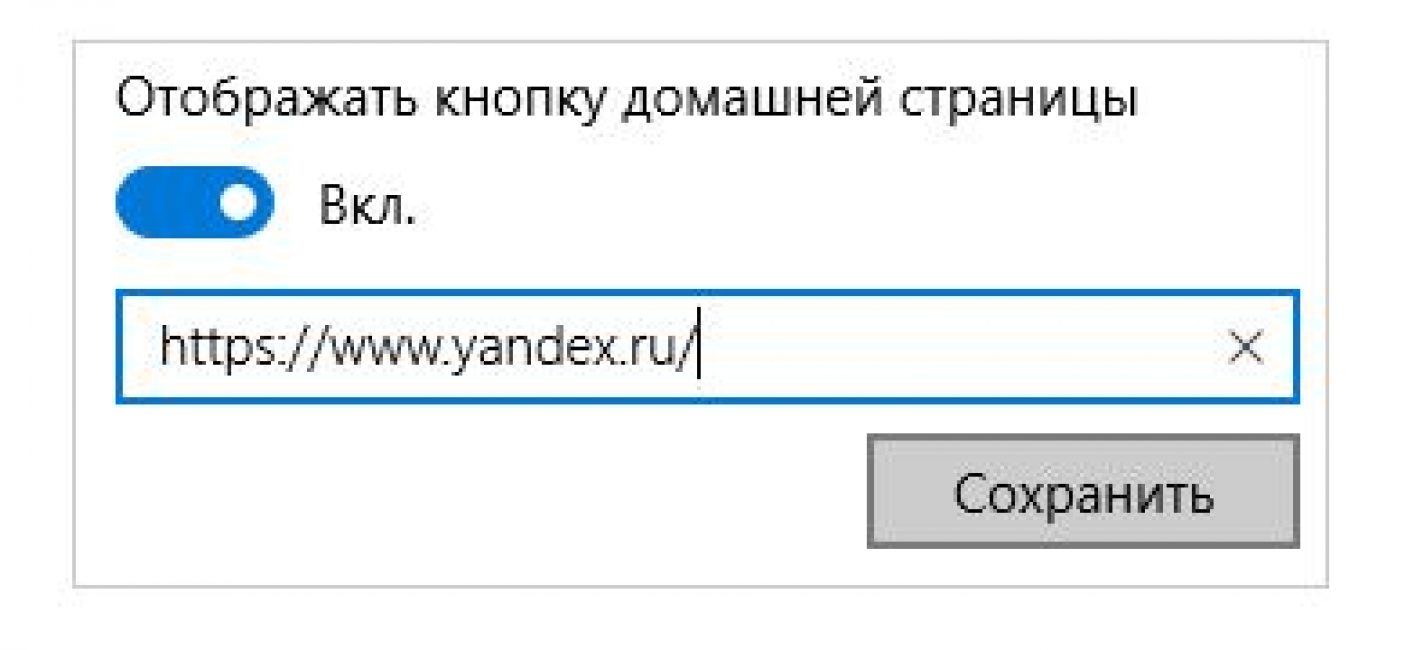
Installation in Google Chrome
Google chrome- the most popular browser according to independent surveys on the Internet, offers us the following way. In the browser, we are looking for the icon "Settings"  and open it.
and open it.
Find the button « Appearance» ... Turn on the add-on Show Home Button .
On the line with the request "Enter web address" enter the required link: "https://www.yandex.ru/". This completes the setup, because all user actions are immediately synchronized with your profile in the browser.
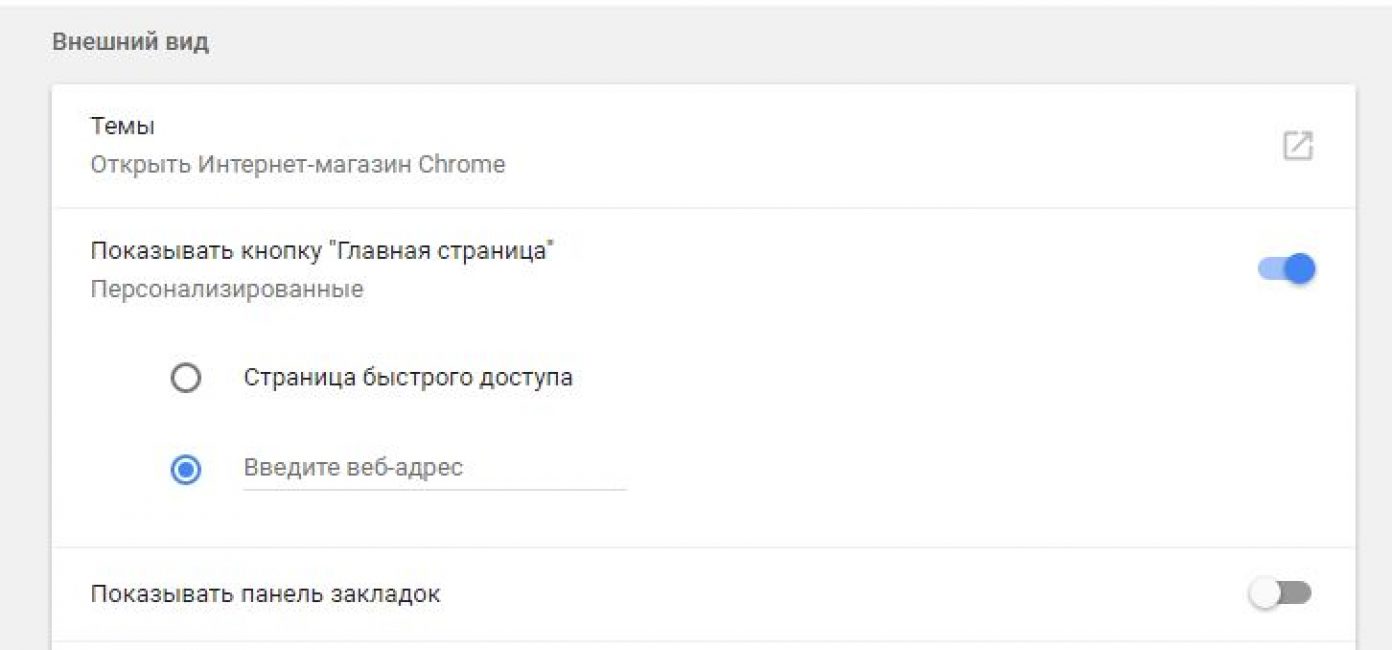
After completing all the manipulations when restarting Google Chrome, it will be displayed when the button is pressed "Home" (image of the house).
And if you want Yandex to load completely automatically, then you should use another installation option. To change you will need:
1 In the Google Chrome menu in the upper right corner, call the command "Settings" .
2 Looking for an item "Initial group" , where we put a check mark (if it is not checked) "Next Pages" .
4 If you are a fan of Yandex, then here you can configure it with the default search engine. In chapter "Search" specify the search engine Yandex.
5 Close the settings. Confirm your actions by pressing a button "OK" no need, in this browser everything syncs instantly.
If you configured your browser as described above, then when you turn on Google Chrome, the pages installed in the initial group (in our case, Yandex) will always open.
There is a shortcut Alt + Home in Google Chrome that will help you quickly open the home page in the current browser tab.
Installation in Mozilla Firefox
On opening Mozilla browser Firefox, you need to click on the icon  and open "Settings"
— "Basic"
.
and open "Settings"
— "Basic"
.
There we are looking for a line "When Firefox starts up" and adjust the value Show home page ... Accordingly, in the line "Homepage" enter the link "https://www.yandex.ru/".

As in Google Chrome, in Mozilla Firefox the transition to the home page is carried out by a combination of hot keys Alt + Home.
Installing in Opera
Supporters of the Opera browser can use the following method: by combining the hotkeys Alt + P to bring up a menu.
Switch to "Browser" to section "At startup" ... Next, click on the link "Set Pages" and in the field "Add new page" enter the path "https://www.yandex.ru/".
After all the operations, we confirm the actions by pressing the button "OK" and set the switch to position "Open start page" .


That is all the necessary steps to achieve our goal - to make Yandex Search the home page in the Opera browser.
After following all the instructions, the browser will automatically open the search engine at startup.
Installing in Safari
Installing Yandex in the Safari browser is considered the easiest option. In the Safari menu, select successively the items Safari , Further "Settings" and "Basic" .
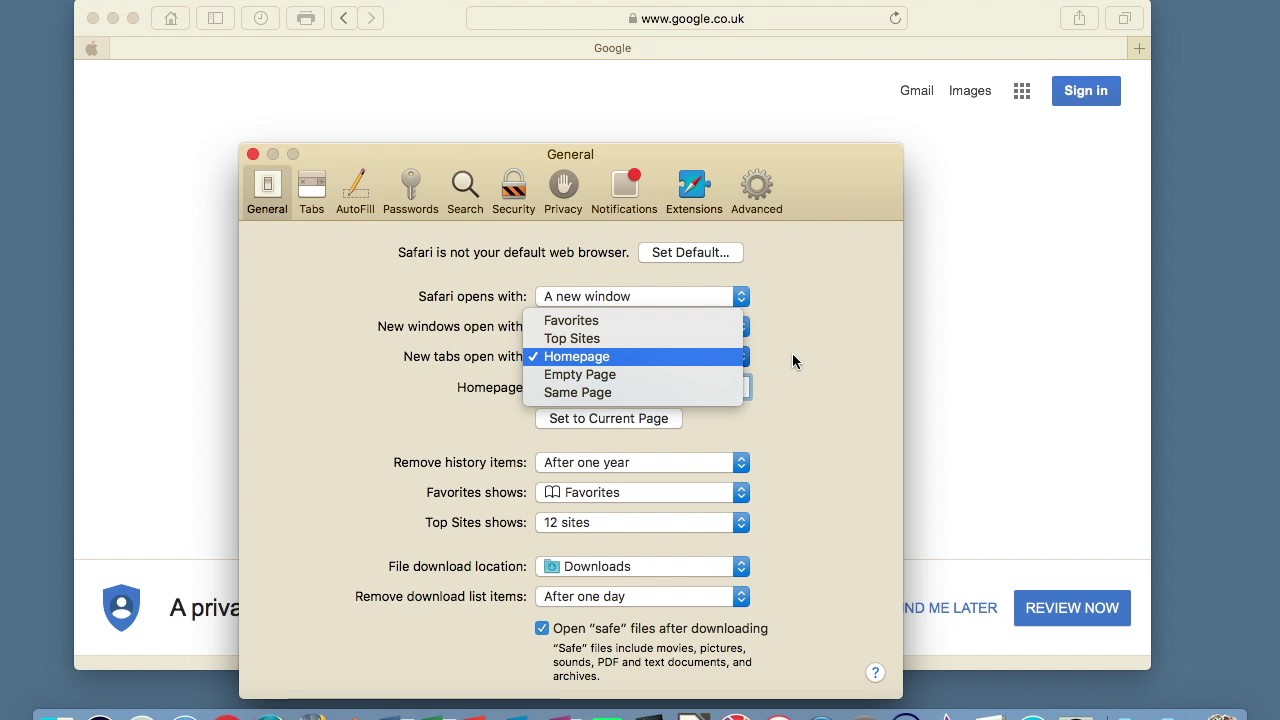

Safari is configured and Yandex is the start page. Congratulations!
After installing Yandex as a home page, you can go ahead and personalize it for the user. Set up your desktop, so to speak.
The process is not complicated if you figure out step by step what needs to be done. Yandex has a huge number of useful, convenient and necessary ones that will make your daily work more comfortable and progressive.
Setting is done by adding widgets to it (icons with the right programs) and changing the interface for the user (a nice theme for your page).
Yandex itself invites us to add and configure widgets in the order that is convenient for us, install any theme, change basic personal settings.
To fully cover the entire range of services provided by Yandex, you should register yourself for correspondence and storage important information online.
Don't worry, they won't be publicly shared with all users. This is a semblance of a personal cell in a bank, where your documents, photos and others are stored.
Save your logins and passwords with LastPass for easy reference.
So, to customize the home page, we need:
- Log in to your Yandex.mail that you registered.
- We open there "Personal settings" and select the menu item "Configure Yandex" .
- We determine which widgets we want to see on the desktop, and delete all unnecessary ones by clicking the cross in the upper right corner of each of them. Don't worry if you delete something by mistake. It is possible to cancel the action with the button "Return" or "Reset settings" ... When you finally decide on a set of widgets, click on the button "Save" .
- Then we go to the point "Add widget" , select the desired categories from the categories, point the mouse cursor over them and click "Add" , after which it is added to the page. Push "Leave" .
- We arrange the widgets in the order we need, moving them to the places we need. Push the button "Save" .
- Go to the menu item "Put the topic" , choose the one you like and click "Save Topic"
So now Homepage acquired a completely different look, pleasant for you, convenient and pleasant to use.
If the start page doesn't want to change in any way? Have you tried all of the above methods, but still loading Webalta, Pirrit Suggestor, Conduit Search or other suspicious sources?
Probably the only problem that every user is likely to face is the inability to change the start page in the browser due to one or another malicious software (software).
And then constantly on the start page we can see how Conduit Search, Webalta or Pirrit Suggestor are loaded, which we do not need in any way. We will analyze how to deal with this further.
Be sure to check your computer for viruses or other malicious programs using an antivirus.
If the antivirus says that there are no viruses, then you will have to look for additional information about removing undetected malware.
In the same way, do not forget to check your browser shortcut. But nevertheless, if a problem occurs and Webalta opens when starting Chroma, Opera or Mozilla, then you should definitely review and check for errors in the properties of shortcuts for launch. This requires:
Column "Properties" in the shortcut of the Chrome browser
2 Next, go to the tab "Label" and looking for a stanza "An object" ... You need to make sure that there is no one or another mention of Webalta after specifying the path to the browser file. The clean one should look like this: "C: \ Program Files \ Mozilla Firefox \ Firefox.exe". If something superfluous is mentioned at the end, then unconditionally delete it and click Apply ... If there is, then we delete this part, after which we confirm our actions by pressing the button "OK" .

Rambler

